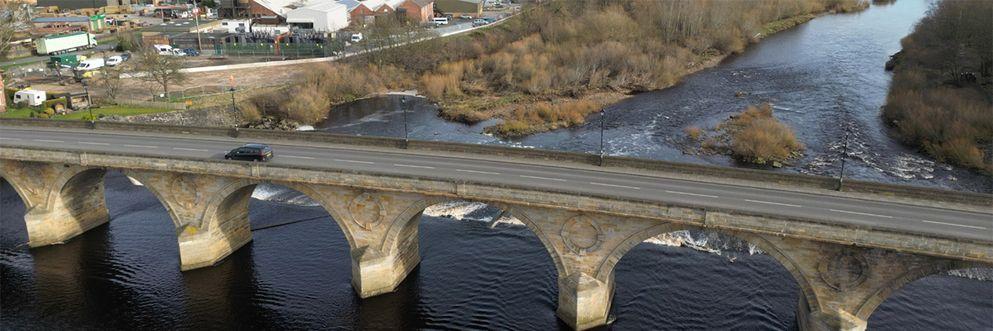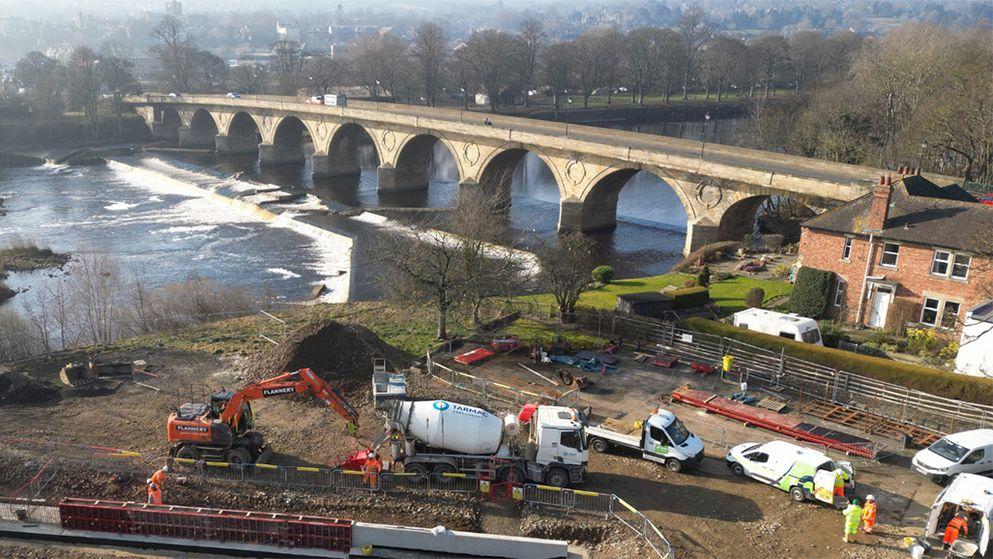
Low carbon concrete turns Hexham flood defences green
Low carbon concrete turns Hexham flood defences green
In a UK first, the Environment Agency, BAM, Arup and Tarmac have successfully trialled the use of two low carbon concrete mixes for works at the Hexham Flood Alleviation Scheme.
The low-carbon concrete has been used across 3 panels, totalling 27 metres of the £6.5 million Hexham flood defences, as part of a plan to reduce the carbon footprint of the construction of flood defences, without compromising the strength and resilience of these structures.
The trials involved the first use in permanent works of a new Portland Limestone Ternary mix developed by Tarmac which has delivered carbon savings of 64% compared to traditional cement-based concrete. Also tested was an Alkali Activated Cementitious Material (AACM) which reduced carbon emissions by 70%, per cubic metre of concrete, across the section of the wall where low carbon concrete was used.
Traditional concrete production contributes around 7% of global carbon emissions and concrete is one of the most-used resources worldwide. Its carbon footprint is due to a combination of the chemical reactions and the energy-intensive methods that go into the production of cement, the key binding element in concrete. Advances in the UK concrete industry mean that concrete currently accounts for around 1.5% of UK carbon emissions.
The trials have been delivered by the Environment Agency’s Collaborative Delivery Framework Hub A, a collaboration between the Environment Agency, Arup and BAM, to deliver flood defence schemes across North East England.
It is hoped that the trials to find new ultra-low-carbon concrete alternatives, will enable future Environment Agency flood defences, across the North East, to be built more sustainably, with lower embodied carbon. They will also support the delivery of new sustainable concrete products, to the wider construction industry.


Ruth Young, Area Carbon and Sustainability Lead for BAM
“As the Environment Agency’s construction partner in the North East, we are carefully considering how we can limit the environmental impact of the flood defence work we deliver without compromising the strength and resilience of these structures.
“We identified Tarmac’s new low-carbon concrete mixes as innovative products, which have the potential to reduce our overall carbon impact across the framework.
“We are working closely with the Environment Agency, Arup and Tarmac, to ensure the materials can be approved for use and look forward to seeing these being used on more civil engineering schemes in the future.”
Hexham is a popular tourist destination in Northumberland which suffered considerable damage from flooding during Storm Desmond in 2015. The Hexham flood alleviation scheme will help to protect up to 90 properties in one of the town’s most important commercial areas, providing increased job security by protecting the places people work, keeping businesses open and supporting the wider local economy.
The flood defence scheme at Hexham is expected to complete in summer 2023. Approximately 600m of flood walls and grass embankments will help to reduce the flood risk posed by the River Tyne.
Leila Huntington, Environment Agency Operations Manager, said: “The Environment Agency is committed to helping the nation be more resilient to flooding, coastal change, drought and climate change. We all have a role to play in tackling the climate emergency which is why the Environment Agency has committed to reaching Net Zero by 2030. To achieve this we have to adapt, try innovative approaches and ensure that climate and sustainability are at the heart of what we do.
“The trial of low carbon concrete in Hexham is a fantastic example of how we can work with our partners to continue to build flood defences to better protect communities from flooding, whilst also focussing on sustainability, the environment and reducing our carbon emissions."
Robert Gossling, Head of Commercial Engineering Solutions at Tarmac, said:
“This flood defence project in Hexham highlights the clear sustainability benefits which can be achieved when clients and contractors work in partnership, in this case engaging to help understand the benefits and reduce the concrete carbon footprint of the Environment Agency. The testing comparisons will help build confidence in these new products.
“Against the backdrop of a climate emergency, the use of these mixes marks another important step for the UK concrete and cement industry along its path to net zero. We’re committed to demonstrating innovation in low carbon solutions, and we hope that the success of this trial will help accelerate adoption of this and other types of new, sustainable concretes – delivering long-term benefits for the industry.”
Donald Daly, Associate at Arup, said: "A successful trial will give us the ability to deliver low carbon solutions for the vital flood defence work which will protect communities not just in Hexham, but across the North East. We can't afford to compromise on flood protection, so finding concretes which significantly reduce carbon emissions while maintaining robust defences represents an incredibly important milestone.
“Arup is proud to have played a part in this work – and will continue to work closely with clients and project partners to deliver high-quality solutions which reduce our carbon footprint.”
The site will be monitored via a rigorous testing regime, to demonstrate the long-term durability and suitability of the concrete mixes and with data collected providing insights into the future use of low-carbon solutions.

